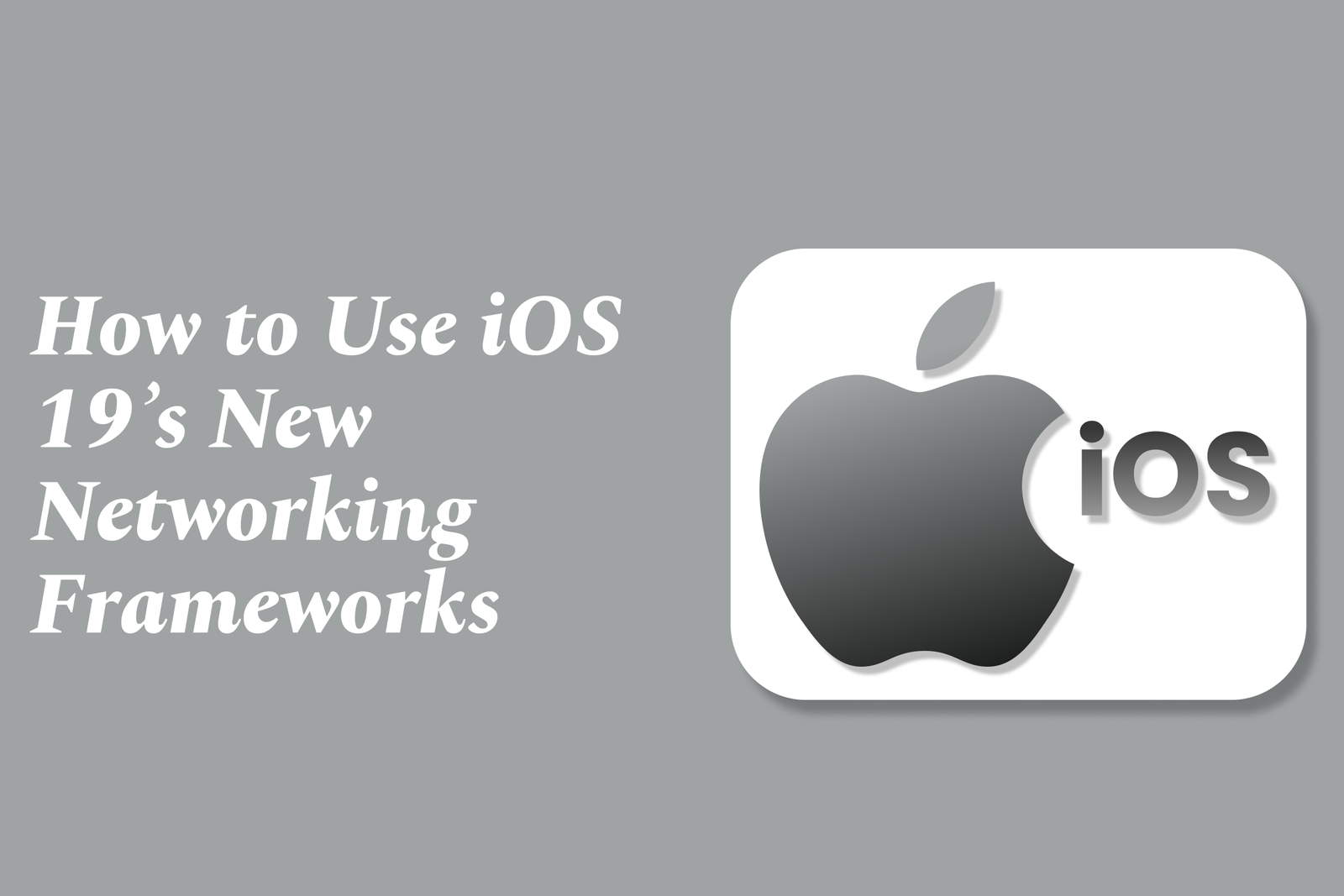How To Use IOS 19?S New Networking Frameworks
iOS 19 introduces enhanced Networking Frameworks that simplify building secure, efficient TCP/UDP connections for client-server apps. These APIs provide better control, streamlined connection handling, and improved performance, making network communication easier and more reliable.
How to Use iOS 19’s New Networking Frameworks
1 ) Introduction to Apple's Network Framework in iOS 19
Apple has introduced new networking APIs and frameworks with iOS 19, providing convenient abstractions for lower layers of the networking stack.
The Network Framework simplifies network communication and offers powerful features beyond what traditional APIs like URLSession provide.
2 ) Key Features of the Network Framework
The framework supports modern networking protocols with better security and performance.
Enables handling of connections, listeners, and network parameters in a streamlined fashion.
Provides first class support for both TCP and UDP protocols.
Facilitates easier implementation of server and client networking functionalities.
3 ) Using the Network Framework to Build Client Server Applications
Developers can set up NWConnection for client side network communications.
NWListener can be used to accept incoming network connections for server apps.
The framework allows monitoring and managing connection state changes effectively.
Provides callbacks and delegate methods for handling network events.
4 ) Advantages over Previous Networking APIs
Improved ease of use and better abstraction of complex networking tasks.
Enhanced compatibility with modern network protocols and security standards.
Greater control over network parameters without sacrificing code simplicity.
Suitable for real time communication apps, streaming, and custom protocols.
5 ) Sample Implementation Highlights
Establishing a connection using `NWConnection` requires specifying the endpoint and parameters.
Listening for incoming connections with `NWListener` includes defining the port and waiting for new connections asynchronously.
Sending and receiving data uses simple handler closures that process incoming and outgoing buffers.
The framework supports cancellation and error handling cleanly.
6 ) Development Tips for iOS 19 Networking
Use the new framework alongside or in place of URLSession for advanced networking needs.
Ensure proper error handling and state monitoring to maintain robust network communication.
Test connections under various network conditions to leverage the framework’s resilience features.
Consult the WWDC 2018 session “Introducing Network.framework” for thorough understanding and examples.
7 ) Addressing Common Issues
The transition from older APIs may require code refactoring.
Attention is needed for CORS and secure connections when developing client server apps.
Developers should be aware of potential changes in networking behavior across iOS versions.
This summary provides an overview of the new networking frameworks introduced in iOS 19, their key features, usage guidance, and practical considerations to help developers leverage the capabilities efficiently.
https://justacademy.in/news-detail/what?s-new-in-swift-playgrounds-5.5
https://justacademy.in/news-detail/swiftui-and-uikit-integration-techniques-for-ios-19
https://justacademy.in/news-detail/flutter-vs-unity-for-game-dev-2025
https://justacademy.in/news-detail/how-react-native-is-evolving-with-the-latest-tech
https://justacademy.in/news-detail/react-native-and-firebase:-the-perfect-pairing-in-2025
Related Posts
In 2025, top Angular libraries offer modern, feature-rich components and tools for building dynamic web apps. From powerful data grids to low-code platforms like UI Bakery, these libraries enhance development speed, UI design, and scalability, making them essential for Angular developers.
Migrating from AngularJS to Angular 17 involves gradually upgrading your app by running both frameworks together using tools like ngUpgrade, rewriting components in TypeScript, and adopting Angular’s modern architecture to enhance performance, maintainability, and long-term support.
Angular state management tools help organize and handle app data efficiently, improving scalability and maintainability. Popular options include NgRx for robust, RxJS-based patterns, and newer Signal Store solutions that offer simpler, reactive approaches integrated tightly with Angular’s latest features.
RxJS in Angular empowers developers to manage asynchronous data streams with powerful operators like `forkJoin`, `combineLatest`, and `zip`. Mastering these key operators in 2025 is essential for building efficient, reactive applications that handle complex event sequences seamlessly.
Angular performance optimization in 2025 focuses on improving app speed and responsiveness by using techniques like OnPush change detection, lazy loading, efficient data caching, and AOT compilation. These practices reduce load times, enhance user experience, and ensure scalable, fast Angular applications.
In 2025, Angular remains preferred for large-scale, enterprise apps with its robust, all-in-one framework, while Vue attracts developers seeking simplicity and fast development for smaller projects. Both frameworks excel, with choice driven by project needs and team expertise.
Angular Signals are a new reactive primitive in Angular 16 that enable fine-grained, efficient change detection by automatically tracking dependencies and updating only affected parts of the UI. They simplify state management and boost app performance, revolutionizing Angular's reactivity model.
Angular interview questions to prepare in 2025 focus on core concepts like components, directives, data binding, routing, and dependency injection, along with TypeScript mastery and latest Angular features to ensure strong practical knowledge for building scalable, efficient web applications.
AngularJS reached its official end of support in January 2022, meaning no further updates or security patches. To ensure app security and performance, developers should consider migrating to modern Angular versions or seek third-party long-term support options if immediate migration isn’t possible.
The Angular Roadmap 2025 highlights upcoming features focused on improving developer experience and performance, including zoneless Angular, Signals integration, enhanced Forms, async data handling, improved HMR, and expanded Angular Material/CDK enhancements, driving modern, efficient web app development.










